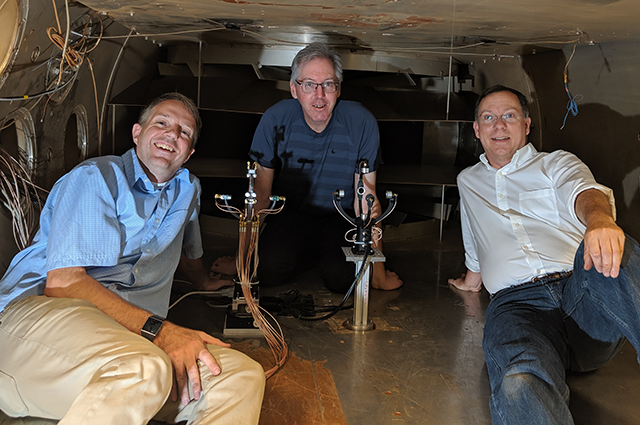Developing a flight-ready sonic anemometer

There’s wide interest in understanding the basic science behind the atmosphere and weather of other planets, particularly when it comes to planning for potential exploration by landing vehicles like NASA’s Mars Exploration Rovers or, someday, astronauts.
“Of all planets available to us, Mars is the most similar to Earth,” Robert White, an associate professor in the Tufts Department of Mechanical Engineering, points out. “Understanding what happened to Mars and its climate over time may give us clues to what’s happening on Earth.”
White is collaborating with Don Banfield, principal research scientist at the Cornell Center for Astrophysics and Planetary Science, and Ian Neeson of VN Instruments to develop a low-power sonic anemometer that could one day measure wind speed on Mars.
Researchers have primarily used heated patch or heated wire sensors to measure atmospheric dynamics on Mars. Higher rates of heat loss denote a faster wind speed. Mechanically these sensors are relatively simple, which is a positive quality for a mission to Mars, where equipment needs to be robust and resilient. However, solar temperature changes on Mars can cause dramatic swings in temperature, making it difficult to calibrate sensors to capture heat loss caused by wind speed rather than by radiative cooling.
The gold standard for measuring wind in a thicker atmosphere, like Earth’s, is a sonic anemometer. It calculates the wind’s effect on the speed of ultrasonic sound waves traveling between a pair of transducers, which allows researchers to determine wind speed in real time. The instrument is faster, more accurate, and provides higher resolution data at a higher update rate than heated wire sensors. Unlike those sensors, a sonic anemometer would potentially be capable of capturing Mars’ large whirling wind structures and eddies that mix air from low to high altitudes.
However, a sonic anemometer also requires more signal processing and relies on sound waves, which is particularly challenging in Mars’ quiet, thin atmosphere. With funding from the NASA Planetary Instrument Concepts for the Advancement of Solar System Observations (PICASSO) Program, Banfield, White, and Neeson want to build a flight-ready sonic anemometer that can thrive in Mars’ harsh conditions.
The team started with tests that demonstrated that there are enough ultrasound signals in an atmosphere like Mars’ – both low pressure and rich in carbon dioxide – for a sonic anemometer to work. With that hurdle crossed, researchers knew the anemometer’s transducers and signal processing could function in a Mars-like environment. Next they needed to test another crucial variable: wind.
In August, the team flew to Denmark to visit the Aarhus Mars Simulation Wind Tunnel, where, with help from facility staff Jonathan Merrison and Jacob Iversen, they tested two prototypes, one constructed in White’s lab at Tufts and one built by Neeson’s team at VN Instruments. At Tufts, M.S. student Henry Shi, EG18, and undergraduate Spencer Schmid, E21, had worked with White to hone the anemometer’s ultrasonic transducers and to 3D print and test mechanical parts. “We’re really happy with how the tests [in Denmark] went,” says White. “We got great data at the end of the week – even better than we expected.”
While the team’s sonic anemometers won’t be ready in time for NASA’s next Mars launch in 2020, the team is planning ahead and staying open to new possibilities. The Mars launch window opens approximately every two years. And, Mars aside, the team’s sonic anemometers could have applications for other planetary explorations or in Earth’s thin upper atmosphere, too. For now, the research team continues to test and refine designs, and to look to the future.
Department:
Mechanical Engineering